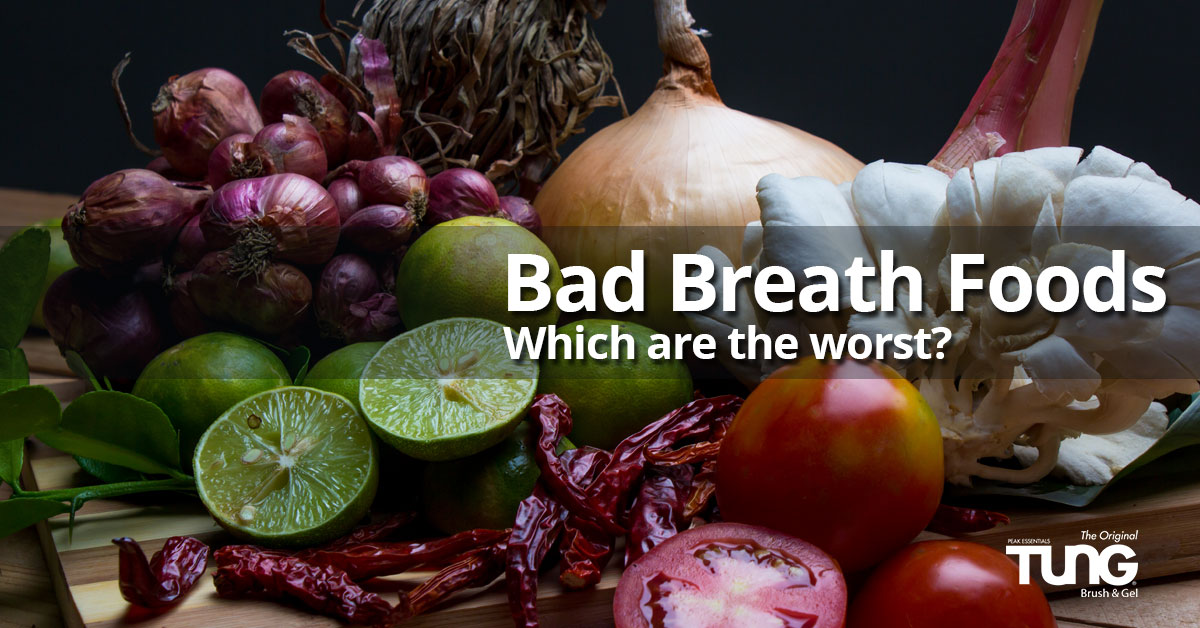You’ve got that big date coming up, or perhaps a job interview… or maybe an important client meeting. But it’s lunch time, and you’ve got a decision to make about what to eat.
What foods will give you bad breath?
Which choices could you make that might actually make your breath smell better instead?
3 Food Factors for Bad Breath
Some things are obvious. We all know that garlic and onions will leave your breath smelling nasty. But have you ever wondered why?
Factor #1: Volatile Sulfur Compounds
These aren’t just in foods. In fact, volatile sulfur compounds (or VSCs for short) are primarily what “bad breath” smells like.
There are a number of different chemicals classified as VSCs, but a couple of examples include Hydrogen sulfide, which has a lovely “rotten egg” smell that is truly unforgettable, and mercaptans, (also called thiols) that range in smell all the way from “garlic” to “skunk.” (I know, right?)
They’re called “volatile” because they convert easily to gas — even at normal temperatures, which is why when you’re around someone with nasty breath, the odor escapes their mouth so easily.
And if you think you’re immune, I’ve got news for you: the bacteria in your mouth actually produce VSCs as a waste product, so we all have them.
But… eating certain foods will actually introduce VSCs to your mouth, which means they’ll be more likely to make your breath stink.
Here are just a few foods that contain volatile sulfur compounds:
- onions
- garlic
- curry
- chives
- leeks
- shallots
Factor #2: Proteins
While the proteins in your food may or may not directly give off an odor of bad breath, they can certainly contribute to a nasty round of halitosis following a meal.
Why?
Because the residual protein in your mouth is a major food source for bacteria.
That’s right: the bad-breath-causing bacteria that thrive on your tongue and in all the other crevices of your mouth love to eat proteins.
And when they eat protein, they produce waste. And that waste is loaded with VSCs (see Factor #1), which means that if you don’t do something about it, you’ll have a fragrant gas escaping your lips and filling the air around you with stink.
This one might be a little more obvious, but here are some of the major protein-rich foods you should be aware of:
- meats
- dairy (including cheese & yogurt)
- beans
- tofu
- eggs
- nuts & seeds
Factor #3: Acidity
Here again, we aren’t really worried about the smell of the acids in your food & beverage choices. Instead, we’re thinking primarily about the impact that acidic foods will have on the odor-causing bacteria in your mouth.
The fact is that these bacteria thrive in an acidic environment. They’re more active, they reproduce faster, and they consume foods and produce waste faster in an acidic environment.
So… if you find yourself consuming lots of:
- coffee
- alcohol
- tomatoes
- citrus fruits like oranges, lemons, limes, etc.
- pineapple
- and so on
…then you may have residual acids in your mouth, which will lead to hasty halitosis.
What You Can Do About It
Well… first things first: if you need to have nice-smelling breath after a meal, you can avoid as many of the above foods as possible.
Instead, choose foods that are low in protein and are alkaline (they’ll reduce the acidity of your oral cavity).
Some examples are:
- green vegetables (other than beans), like broccoli, celery, cucumbers, kale, lettuce, and carrots
- non-citrus fruits like apples, bananas, berries, grapes, melons, etc.
What Else You Can Do About It
First: drink lots of water. If you lay off the alcohol, coffee, and sugary acidic beverages and drink lots of water (especially after your meal), you’ll stand a good chance of rinsing the VSCs, protein, and acidity out of your mouth. Water is neither acidic nor alkaline, but it does do a good job of minimizing acidity.
Second: clean your tongue. Sure, you might brush your teeth after the meal, but keep in mind that 90% of the bacteria that cause bad breath live on your tongue, not on your teeth. We’ve even prepared special information to help you learn how to clean your tongue without gagging.



I’m just wondering does eating grapes or grapes juice cause bad breath?
What are the negatives in eating this fruit?